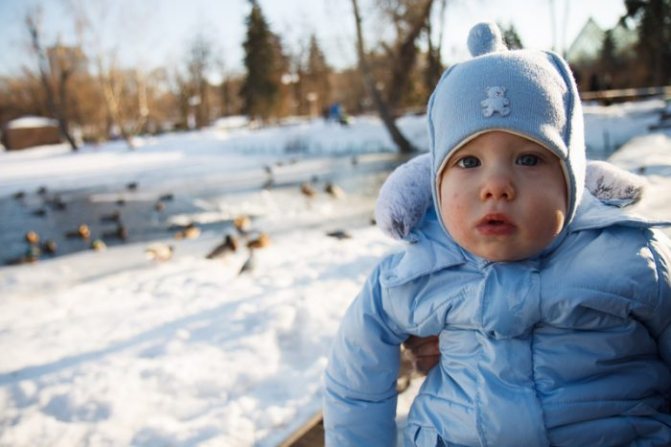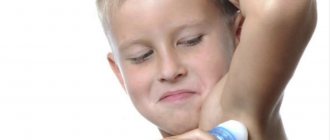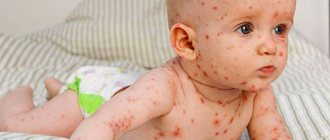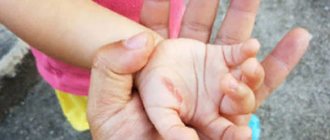When can you go for a walk if you have chickenpox in children?
If your child complains of weakness and fever, and there are reddish spots on his face, congratulations, he most likely has chickenpox. Often, many parents themselves suffered from this disease in childhood and immediately begin to “art”, smearing their child with brilliant green. However, many questions are ignored. Some people are lucky and the child easily tolerates the disease, while others are not. In order not to risk your baby’s health once again and to be ready to respond to chickenpox in a timely and adequate manner, we suggest that you read this article, in which you will find out whether it is possible to go for a walk if children have chickenpox
Why you shouldn't walk if you have chickenpox
First of all, chickenpox is a viral infection caused by a virus of the herpes family type 3. The name of this virus is Varicella zoster. The virus has its own characteristics:
- High level of contagiousness (a person actually has no immunity to this virus);
- Weak stability in the external environment (when the virus enters the air from the host’s body, it quickly dies under the influence of ultraviolet radiation - sunlight);
The main route of spread of the virus is the air, where it enters in tiny particles of the carrier’s saliva and can spread up to 100 meters from the carrier. This fact indicates the high degree of volatility of the virus. This “flying” feature is complemented by all kinds of gusts of wind and the ability to spread, bypassing natural and artificial barriers (through elevator shafts, through ventilation, etc.). It is worth adding that the virus enters the body only when it comes into contact with the mucous membrane of a healthy person, which occurs during the respiratory process.
Based on the above characteristics of the virus, doctors use quarantine measures to localize the spread of infection. When walking in the fresh air, there is a high probability of infection of healthy people:
- The virus can be transmitted to a healthy child. This, as a rule, is not so scary and many parents will not blame you, since childhood chickenpox is usually mild. However, chickenpox in a sick child can take a moderate or severe form, and this leads to very serious difficulties in treatment and can cause various dysfunctions of the body;
- A child can infect a pregnant woman. Under such circumstances, there is a high probability of infection affecting the fetus, which in turn can lead to miscarriage, fetal death, the development of various pathologies of internal organs, deformities, etc.;
- The virus can enter the body of a healthy adult who has not previously had chickenpox. In older age, chickenpox usually takes on a moderate or severe form, and for an adult this can be fatal. Let us add to this that chicken pox in adulthood can often cause the development of disorders of the nervous system, as well as a number of other vital systems of the body. Cases of complications of chickenpox in adults are not uncommon;
- The virus can infect a healthy teenager who does not have immunity to the chickenpox pathogen. In adolescence, chickenpox is often severe, which means that the consequences of the disease can be the most tragic;
- The infection can enter the body of a baby under the age of 1 year. In this case, the course of the disease can be severe and lead to all sorts of complications and disruption of the functioning of internal organs and life support systems. This is due to the weak and undeveloped immune system of children under one year old, therefore, their susceptibility to all kinds of viruses and bacteria is very high;
In addition to the above reasons, a high temperature with chickenpox in a child can become a serious obstacle to walking in the fresh air.
Why you need to walk when you have chickenpox
Sometimes parents wonder whether it is possible for children to go for walks with chickenpox, and often do not risk exposing the baby to the risk of complications, as well as those around them, among whom may be pregnant women, infants or adults without immunity. However, some experts insist on easy promenades, but only when the child feels well and the illness has gradually subsided.
The fact is that when walking, air exchange occurs, the cells are more quickly saturated with oxygen and remove toxins, thereby easing the patient’s condition. When the virus gets into an open environment, it dies faster, which also has a positive effect on the course of recovery.
Regular walks in the fresh air strengthen the immune system, making it easier for the body to fight a viral infection, and recovery occurs faster. The baby’s mood improves as the environment changes, which also has a beneficial effect on well-being.
When can you go for a walk, according to doctors?
As we said earlier, doctors recommend observing quarantine measures during the period of illness. A person is considered infectious 2-3 days before the first elements of the rash appear. After 5 days from the moment the last rash appeared, the patient is no longer contagious. And if you ask doctors: “When can children go for a walk if they have chickenpox?”, then often the answer will be: “You can go for a walk after chickenpox.” At the same time, you need to know some recommendations when walking in the fresh air after suffering from this disease:
- The child's immune system is very weakened after infection. For this reason, it is recommended to avoid crowded places, as there is a high probability of “catching” some other infection;
- After an illness, the baby’s skin has increased sensitivity to ultraviolet radiation, so the child should avoid being in direct sunlight;
- For some time after recovery, you should refrain from active activities and games, as the body is very weakened. It is worth considering options for educational games;
- It is strongly recommended to avoid hypothermia, but this does not mean that the child needs to be wrapped in three layers of clothing. You should dress according to the weather. For this purpose, it is advisable to choose clothes made from natural and breathable materials;
- Swimming in rivers or lakes until the rash has completely healed is prohibited, as there is a high probability of infection in the wounds;
When is it okay to go outside if you have chickenpox?
The duration of the illness lasts no more than 10 days. This is quite a long time, and the person is already looking forward to how many days later he will be allowed to go outside. If the acute stage of chickenpox has passed, a recovery period has begun, the disease proceeded without complications, then you are allowed to breathe fresh air 5 days from the moment the last bubbles appear. At this time, the rash is already covered with crusts, and the pathogen is eliminated from the body.
Many doctors believe that walking during chickenpox is not only possible, but also necessary. The Varicella Zoster virus is vulnerable in the external environment and quickly dies when exposed to ultraviolet radiation. That is, the sun's rays have a beneficial effect on the body during chickenpox and strengthen the immune system
The basic rules for when you can walk outdoors when you have chickenpox are as follows:
- the disease was mild;
- the person does not have a febrile syndrome;
- the patient is alert, active, his health does not suffer;
- the skin is covered with crusts and there are no new pustules.
An adult himself decides on which day he can go for a walk without harming his health. Parents of the baby should focus on his general condition.
Remember! A patient with chickenpox should not go to the clinic so as not to infect other patients. You should call a doctor at home.
When can you walk with chickenpox in children: on what day, are walks allowed if there is no fever
Chicken pox is one of the most common diseases. Most people manage to get sick from it at the age of 2-10 years. Children usually tolerate the disease easily. Therefore, they quickly get bored with home quarantine; they want to quickly get out of the house for a walk, play with friends in the fresh air.
Loving parents, naturally, indulge their child’s requests to let him out for a walk at least for a short time, neglecting consultation with a pediatrician. But only a doctor can clearly say whether it is possible to walk with chickenpox or not, and whether it is dangerous for children.
Is it possible to go outside and take a walk if you have chickenpox?
Chickenpox is caused by the Varicella Zoster virus, which enters the body through the respiratory tract. A person becomes a source of infection 48 hours before the appearance of blisters and throughout the entire period of illness. Doctors recommend completely eliminating communication with others at this time. On the other hand, when you feel better and your temperature normalizes, you want to go outside and breathe fresh air. Is it possible for adults to walk with chickenpox or is it better not to do so? It all depends on the form, stage of the disease and the general condition of the patient.
Is it possible to walk if you have chickenpox?
Many parents believe that chickenpox is a harmless infection, since most children tolerate the disease quite easily. There are even especially “caring” mothers who go to visit an infected child in order to get over chickenpox as early as possible. For the same reason, some children's institutions refuse to impose quarantine during a chickenpox epidemic.
Chickenpox can be dangerous, since some children have great difficulty enduring such pathologies and suffer complications both during and after the illness.
Parents who have a democratic attitude towards their children should think about those children for whom chickenpox will cost their health, and stop wanting to infect others with chickenpox.
The answer to the question “is it possible to walk with chickenpox?” will be "NO".

Is it possible to walk with chickenpox?

The benefits of walking in the fresh air are beyond doubt. There is an opinion that a “harmless” childhood illness is not a ban on walking on the street or in the yard. The opinion is erroneous, and the answer to the question of whether it is possible to walk with chickenpox is negative, since it is dangerous for others and the patient himself.
Chickenpox in childhood is a relatively safe disease. In most cases, it is tolerated in a mild form and does not lead to subsequent complications. However, it has a high level of contagiousness.
Important: any contact of a virus carrier with a healthy child or adult who has not been sick before will lead to infection.
In adults, the pathology always occurs in a severe form. For a pregnant woman, the danger is extremely high. Risks include the following aspects:
- In very early stages there may be a miscarriage;
- When infected in the first trimester, the likelihood of intrauterine development disorders increases;
- Infection after the 36th week of pregnancy can lead to the death of the baby, or he will be born with congenital chickenpox, which he will contract during passage through the birth canal.
Walking a patient in the acute phase with pronounced clinical manifestations is a high risk of complications of chickenpox - meningitis, encephalitis, pneumonia, etc.
Why you can’t go for a walk - 3 important points
- Chickenpox is not an easily tolerated infection for all patients. Some children have difficulty surviving smallpox. Already from the first days of the disease, they develop a high fever, which lasts for about a week; the whole body is covered with a profuse rash that is very itchy. Because of this, they eat practically nothing, sleep poorly, and languish from constant discomfort. Infections are especially dangerous for children with chronic pathologies and symptoms of immunodeficiency. No one is also immune from complications (for example, pneumonia or encephalitis).
- An adult can also get chickenpox. An infected child can infect an adult, and adult chickenpox is much more serious than childhood chickenpox. In adult patients, there is a high likelihood of complications, scars and cicatrices on the skin after a rash. Transmission of the virus to a pregnant woman.
- During pregnancy, a woman's body is especially vulnerable to infections. Even a common cold can cause serious complications for the fetus. Chicken pox, which a woman contracts in the first trimester, threatens the appearance of severe pathologies in the unborn baby. The disease can provoke chickenpox in a newborn immediately after birth. You should not listen to those people who say that you can walk outside with chickenpox. The patient is isolated from other people for 2-3 weeks. No walks, visits or receiving guests are also allowed.
It is especially important to follow these rules if the baby has a high fever and a progressive rash.

Is it possible to go outside if there is no temperature?
Lack of fever is not always a plus. Most often, this signals that the child’s immune system is weakened and cannot adequately fight infection. This “mild” form of chickenpox hits the skin and internal organs much harder.
The absence of fever during the course of the disease does not mean that the child can be allowed to leave home.
With this course of the disease, the infected person is not only capable of infecting others, but also getting complications himself. After all, the immune system does not fight the virus, the body is weakened, which means walking in the fresh air increases the risk of acquiring other diseases or worsening existing ones.
Is it possible to go outside if you have chickenpox and when can you walk with your child?
Chickenpox or varicella is an infectious disease that is transmitted by airborne droplets from a sick person to a healthy person. The cause of the disease is the Varicella Zoster virus, which is also called human herpesvirus type 3. Chickenpox most often affects children older than 6 months, since they do not have protective antibodies to the smallpox virus. Up to 6 months, the baby is protected by maternal antibodies, which are passed on through breast milk. In childhood, the disease is mild. In adults, the infection is registered less frequently and is characterized by severe chickenpox.
When can you go outside?
If chickenpox has so many contraindications to walking, then a logical question arises: when can you walk with chickenpox, or should you wait until you have fully recovered?
Suprastin for chickenpox in children: dosage
Chickenpox is an infectious disease caused by the Varicella Zoster virus. The likelihood of clinical infection developing when...
Walking is allowed when at least 5 days have passed since the last rash. This means that the contagiousness of the infection has decreased and the child ceases to pose a danger to others.
Another point is that the baby tolerates the disease well, he does not have weakness, fever or any complications. Then short-term promenades in warm, windless weather in deserted places will promote oxygen exchange and will not cause harm to random passers-by.
About the pathogen
The incubation period of infection ranges from 14 to 21 days. This time is necessary for the chickenpox virus to gain a foothold in the body and prepare for further expansion. After incubation, the patient develops a papular rash, which transforms into vesicles and then into crusts. At the same time, discomfort appears in the area of the rash, general malaise, and the temperature rises. After illness, the child’s immunity becomes immune to the virus. Re-infection is possible only with a pronounced weakening of the body's defenses.
So is it possible to go for a walk if you have chickenpox to give your baby some fresh air? Or is walking still prohibited?
Chickenpox: routes of transmission, incubation period, duration
Is it possible to walk outside if you have chickenpox?
We can see how many parents allow their child with chickenpox to roam freely outside without any restrictions. After all, fresh air during a walk will help the baby recover faster, but how could it be otherwise? At the same time, they underestimate the degree of risk of infection of surrounding children and adults.
Epidemiologists have clearly established the period of contagiousness of patients with chickenpox. A person becomes a source of infection 48 hours before the first papular rash appears! That is, a child can walk outside with chickenpox during the first days of illness and easily infect others. In this case, you will not know that the baby is sick. Contagiousness persists throughout the entire period of the disease, until the last rash appears in the form of crusts on the skin.
If you have chickenpox, it is not recommended to walk outside, since there is a high risk of infection in healthy people. This is due to the high contagiousness of the causative virus, which for Varicella Zoster can reach 90% and even 100%. That is, out of 100 contact persons who have not previously had chickenpox, at least 90 people are sure to become infected.
Therefore, patients with chickenpox are isolated at home for the entire period of illness. And kindergartens, school classes and even entire dormitories are quarantined. It lasts for 21 days, that is, for the maximum possible incubation period.
How long should you not go outside if you have chickenpox?
An infected person faces the risk of infection throughout the entire period of illness.
Therefore, resuming walks in the fresh air is recommended after recovery. It is worth knowing certain periods during which the disease can spread. An infected individual is believed to become contagious when symptoms appear, although this is not entirely true. There are cases when the symptomatic picture appears as a consequence of chickenpox exanthema. Therefore, if we talk about timing, a sick person becomes infectious 1-3 days before the appearance of characteristic primary roseola (spots).
Throughout the entire period of the rash, the person is contagious. Moreover, the risk of infecting others is much higher than before. As a rule, this period of time differs for patients of different ages, and if we calculate the average statistical figure, it will be as follows: from 5 to 12 days, where 5 days is the time of the minimum period of rashes in children, and 12 days is the time of the maximum period of rashes in adults . The data are statistical and refer to typical forms of chickenpox, that is, we do not take atypical ones into account, since they are a rare occurrence.
The appearance of the last foci of exanthema indicates a decrease in the activity of infectious processes in the body, which indicates a speedy recovery. Doctors note that for 5-6 days after the last rash on the skin, the patient remains contagious.
Having identified key information, we can make calculations and answer the question: “How long should you not walk if you have chickenpox?”
You will have to refrain from walking for 11 to 21 days. Do not be ill.
source
Why you shouldn't walk with chickenpox
Walking with chickenpox is not recommended for the following reasons:
- The high contagiousness of the pathogen, which determines the risk of further spread of infection and the formation of an epidemic.
- Weakness of the immune system, risk of additional infection.
- Rarely occurring severe forms of the disease require hospitalization and isolation of the sick child.
The disease in children is quite mild and lasts no more than 10 days. However, due to the risk of spreading infection, walking is still not recommended. This is the best time to stay at home under the supervision of your parents.
Walking with chickenpox is also prohibited because during the period of illness the child’s body is weakened. Walking can lead to hypothermia of the body and provoke the addition of an additional respiratory infection such as ARVI, influenza-like diseases or inflammation of the ENT organs. This will not only slow down the healing process, but will also greatly weaken the child’s already overloaded immune system.
During an infectious disease, the child needs rest, and fresh air can be allowed into the room simply by ventilating the room. As an alternative to walking, you can spend more time on the balcony or loggia.
Is quarantine necessary for chickenpox - Dr. Komarovsky
When can you walk with chickenpox?
When a child with chickenpox feels normal, he invariably asks the question: “when can you go outside?” Each parent has his own ideas on this matter. However, based on epidemiological considerations, all infectious diseases doctors do not recommend walking until the very last day of illness.
At the very beginning of the disease, the child should observe strict bed rest, so you should not even think about any walks. During the height of the infection, when a papular-pustular rash appears, fever and aches appear. At this time it is better to stay at home. Here the child will recover faster, and the risk of complications will be minimized.
The earliest time when walking with chickenpox is allowed is when the baby’s condition returns to normal, the fever disappears and returns to normal. The formation of new rashes should also stop. At this time, short walks away from crowded places are allowed. However, despite feeling well, the child is still contagious to other people. With this in mind, it is still best to stay home during this time so as not to expose others to the risk of infection.
The optimal solution at this stage of the infection process would be a walk in nature. The distance from crowds and fresh air will make the walk as productive and useful as possible.
Walking with a child with chickenpox in the active stage is allowed only with a mild form of the disease, when infection occurs with a small amount of the virus. The mild form is characterized by little or no fever, a small and mild rash, and the child feeling well.
After the last rashes appear and crusts form, the child becomes non-infectious. He can again attend organized groups and go for walks.
What rules must be followed
When going outside with chickenpox, you must follow some rules:
- You need to choose the right time for walking. It is better to go outside in warm, sunny and not windy weather. If there is no temperature, and the weather outside is excellent, then there is no reason to keep the child locked up. Direct sunlight has a disinfecting effect and stimulates the immune system. Therefore, such walks will help the body cope with the infection faster.
- For a walk, dress strictly for the weather - the child should not freeze or overheat. Uncomfortable temperature is stressful for the body and aggravates the course of the underlying disease.
- Avoid excessive activity in your baby's activities. This will protect him from injury. Additionally, this will help the child not to overheat, not sweat, and ultimately not catch a cold.
- Walking in winter with chickenpox is allowed, but only for a short time and in good sunny weather. The cold air that the child inhales greatly reduces the internal temperature, inhibits metabolic processes and slows down the healing process. In addition, in winter there is a higher risk of hypothermia. Therefore, it is better to replace winter walks with chickenpox with regular ventilation of the room.
- Avoid contact and, if possible, walk in deserted places. Chickenpox is a highly contagious infectious disease. The fewer contacts, the lower the risk of developing an epidemic.
- Avoid getting dust and dirt into the opened vesicles, since any violation of the skin serves as an entry point for infection. It is not uncommon for chickenpox to go from a mild form to a complicated form with purulent skin diseases. To disinfect pustules, use brilliant green or any other skin disinfectant solution.
If you follow these recommendations, you can safely walk during chickenpox.
How to treat chickenpox in children - Doctor Komarovsky
How and where to walk when you have chickenpox
After illness, you cannot visit cinemas, shopping centers, playgrounds where there are crowds of people. After all, chickenpox is a volatile infection with airborne transmission, and staying in a crowded place contributes to its spread. A gauze bandage in this regard is not a guarantee of protection. Through the fibers of the mask, viruses with droplets of saliva freely enter the environment and infect others.
The best place for walking when you have chickenpox is in remote corners of parks and quiet streets. Ideally, if you have your own house with a plot of land, then you can breathe the air in the yard. It is allowed to go out onto the balcony, although the spread of infection in this case cannot be ruled out.
After illness, it is important to dress appropriately for the weather so as not to freeze or overheat. An uncomfortable temperature puts the body in a state of stress, which has a bad effect on the immune system. The ideal option is cotton clothing, which allows air to pass freely and allows the body to breathe. The material should be soft so as not to irritate the skin damaged by chickenpox.
When you can safely go outside if you have chickenpox, it is in windless, dry and sunny weather. In winter, it is advisable to limit the time spent outside, as the risk of hypothermia and the development of complications (pneumonia) increases. While walking, you should not actively move or run, otherwise the person will sweat and get sick. You should not be outside during hot times of the day to avoid overheating.
It is recommended to wear sunglasses when walking after chickenpox. The virus affects the retina and increases its sensitivity to sunlight. During the recovery period, the skin is more sensitive to the effects of ultraviolet radiation, so you should go outside in closed clothes. It will also protect against microorganisms getting into the wounds.
Swimming in reservoirs is allowed after the crusts fall off. Even clean water contains bacteria that can cause pustular rashes.
Walking after chickenpox is not forbidden. Moreover, the sun's rays have a beneficial effect on the immune system, kill the virus and speed up recovery. When you decide to go outside, you need to evaluate your own well-being. If you have body aches, headache, nausea and general malaise, it is better to refrain from walking. It is important to take care not only of your own well-being, but also of the health of those around you. Many people have not had chickenpox, but their infection can lead to many serious consequences. Post Views: 883 Tags: go outside, walk
New and popular:
- Can children have chickenpox without fever?
Chickenpox, which people who are far from special terminology call chickenpox, is highly contagious in nature... - Breathe warming gel for children I very often apply all sorts of rubs on my child so that the cough goes away as quickly as possible. One day even goose fat...
- Chest collection for children In case of respiratory diseases, there is a need for drugs that effectively cope with cough. Besides the usual...
- When does chickenpox cease to be contagious in children? Chickenpox is a fairly contagious infectious disease that is caused by the herpes virus, which belongs to the third type. The main thing...
When can you go for a walk after chickenpox?
The patient remains contagious for 5-7 days after new elements of the rash appear on the skin. No more than 10 days after the onset of the disease, pustular rashes dry out and form crusts. This is the time when you can walk after chickenpox without fear of harming your baby’s health in any way. However, the body will still be somewhat weakened for some time. Therefore, dose your walks and gradually increase their duration.
After the illness, the child will develop a sufficient number of protective antibodies, which will ensure further immunity of the body to the Varicella Zoster virus. However, a significant decrease in immunity can provoke re-infection with the development of herpes zoster. Therefore, pay increased attention to fortification and healthy eating.
Take care of yourself and your child! For any infectious disease in a child, it is recommended to consult a pediatrician. Chickenpox is no exception, even despite its mild course.
source











